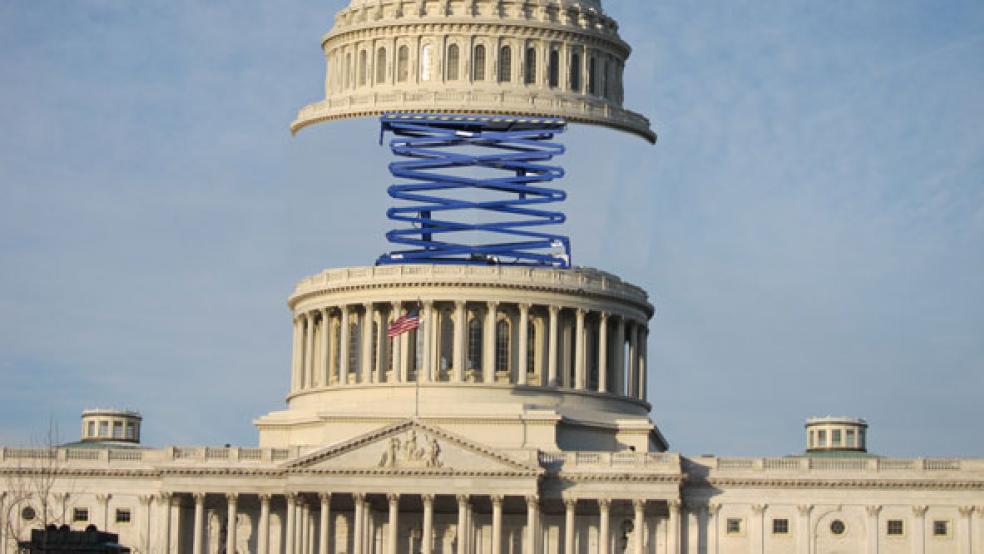In a bid to better position itself in the run-up to negotiations with the Obama administration over looming spending and tax issues, the House GOP is prepared to pass legislation tomorrow that will take the debt ceiling off the table through mid-May.

But instead of voting to increase the Treasury’s $16.4 trillion borrowing authority by hundreds of billions of dollars or more, the Republican measure would temporarily suspend the debt ceiling through May 18. It’s a loophole that lets Republicans claim they didn’t raise the government’s borrowing authority and calms down any fears of a potential default.
The measure is designed to give the White House and congressional leaders time to thrash out differences over government funding and more than $100 billion of automatic cuts in defense and domestic programs scheduled to take effect next month.
RELATED: The Debt Ceiling: What Exactly Is It?The House Ways and Means Committee unveiled the measure yesterday amid President Obama’s inaugural ceremonies and festivities. It is due to hit the House floor on Wednesday, after a hearing today in the House Rules Committee.
Rather than threatening another showdown over the debt ceiling that could lead to the first default ever on the national debt, Republican leaders emerged from their three-day retreat in Williamsburg, Va., armed with a plan that would essentially set aside the debt ceiling controversy for three months, as the Republicans press for deeper savings and entitlement reform.
The bill also seeks to force both chambers of Congress to pass a budget by April 15, threatening in a constitutionally questionable provision to withhold lawmakers’ pay until the job is complete. According to the bill, the salaries of members of either chamber that fails to approve a new budget on time will be held in escrow until a budget is adopted or until the expiration of the new 113th Congress.
That provision is squarely aimed at Senate Democrats, who haven’t approved a new budget in nearly four years. Obama said on January 14 in a White House press conference that he won’t negotiate with Republicans on the federal debt ceiling as he did back in the summer of 2011 when Congress and the administration put the government a day away from defaulting on U.S. debt.
It was unclear early Tuesday how Senate Democrats would respond to the measure, assuming it is adopted by the House, the Washington Post reported. But Sen. Charles E. Schumer, D-N.Y., said Democrats are planning to draft a budget for the first time in nearly four years, and White House political adviser David Plouffe on Sunday welcomed the return to “regular order” after two years of careening from crisis to crisis on the budget.
House Republicans have recently struggled to get support within their own caucus on tax and spending issues. The majority of the caucus opposed two different fiscal cliff plans that featured tax hikes, in addition to voting against a $50 billion-plus bill to repair the damage caused by Hurricane Sandy because the measure did not include spending cuts to offset the cost.
Conservative opposition to their debt ceiling workaround has been muted. The fine legal distinction between a suspension of the cap and an increase was satisfactory to the Club for Growth, which funds GOP primary challengers and disapproved of the potential cliff deals and the Sandy relief spending.
“The Club for Growth will not oppose tomorrow’s vote on the debt ceiling,” said the organization’s president Chris Chocola. “The Club for Growth will, on the other hand, strongly oppose any efforts during the upcoming debate over the continuing resolution and sequester that fail to arrest out-of-control spending and put sensible limits on the growth of government.”
The debt limit is the statutory maximum amount that the U.S. government can borrow at any given time. Currently, the limit is set at $16.39 trillion. Each year, the government spends more than it takes in, and this gap must be funded with debt, or more specifically, bonds issued by the U.S. Treasury. By law, however, the Treasury can’t issue new debt once the country is at its borrowing limit – and this limit, or ceiling, needs to be agreed to by Congress.
As Obama and the Democrats have stressed, the debt limit doesn’t authorize new spending; instead, it provides the funding to pay for spending commitments that Congress has already made. Since the Treasury can’t issue new debt once the limit has been reached, the government would be forced to slash spending if it exceeds the borrowing limit. The result would be a partial government “shutdown” and a debt default.
Many Republicans view the debt ceiling – which dates back to World War I – as an important spending discipline that is important to the long term health of the economy. House Ways and Means Committee Chairman Dave Camp, R-Mich., is holding a hearing today on the history and utility of the debt ceiling, and whether the Constitution provides options to the executive branch when the debt limit is reached.
“The debt is not just some number – it has a direct impact on American families,” Camp said in a statement in advance of the hearing. “During the president’s fiscal commission, we heard nonpartisan testimony that stated when the debt is this large in comparison to the economy it costs the country the equivalent of about one million jobs.”
Josh Boak of the Fiscal Times contributed to this report.
/html>



